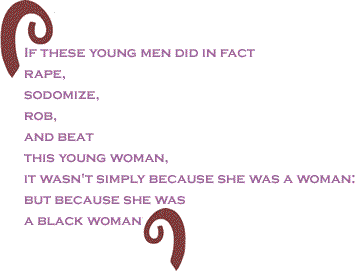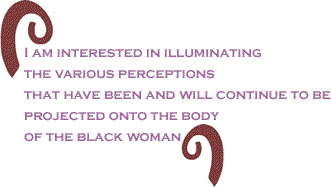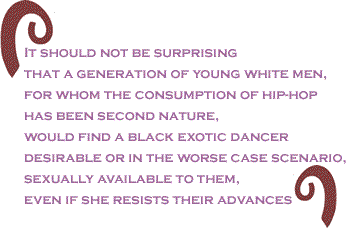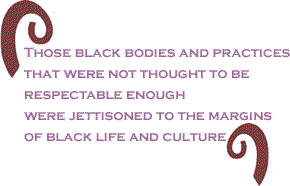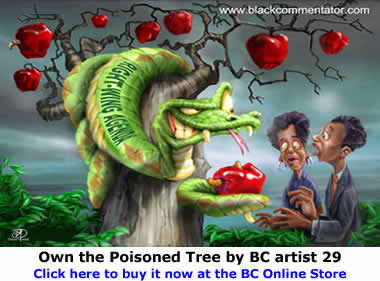
|
|||||||||||||||||||||
 |
|||||||||||||||||||||
 |
|
This article previously appeared on Pop Matters and Prof. Neal's blog, NewBlackMan. In the interim since the article was written, two young white men have been charged in connection with the alleged crime against a Black woman. "As a black female, you go to a party, you're expected to dance, you're expected to be sexually provocative. You [are expected to] want to be touched, to be grabbed, to be fondled... As if they're re-enacting a rap video or something. As if we're there to be their video ho, basically. We can't just be regular students here. We can't just go to a party and enjoy ourselves." – Audrey Christopher and Danielle Terrazas Williams (The Independent Weekly, "Not your video ho," 29 March 06). "Because the intersectional experience is greater than the sum of racism and sexism, any analysis that does not take intersectionality into account cannot sufficiently address the particular manner in which Black women are subordinated." – Kimberle Crenshaw, "Demarginalizing the Intersection of Race and Sex." When a young black women was allegedly raped, sodomized, robbed and beaten by members of the Duke University Lacrosse team on 13 March of this year, it was initially treated as little more than another case of "(privileged) boys gone wild". As word began to spread about the specifics of the case, various communities mobilized to lay claim to its significance. These groups include Durham, North Carolina residents with long-standing grievances against the University, activists rightfully protesting yet another incident of alleged sexual violence related to a college campus, members of various black communities who wanted to highlight the racist implications of the alleged assault, and of course, those who felt that too many people were rushing to judgment about the alleged rapists, well before the true facts of the case were established. At the center of all of these claims and allegiances is the body of a young black woman, who in many ways has been continually assaulted since 13 March. This time the assaults, arising from various narratives surrounding the case, include the inability to take seriously the realities of racialized sexual violence against women of color.
In spite of all the discussion, to date no charges have been filed in the so called "Duke lacrosse rape case." [Two white males have since been charged, as explained, above.] The results of a DNA analysis taken afterc the alleged attack suggest that the members of the Duke lacrosse team were not involved in the attack, though the local district attorney will continue to pursue the case. As such, I am less interested in trafficking through declarations of guilt and innocence in the case, but rather, I am interested in illuminating the various perceptions that have been and will continue to be projected onto the body of the black woman who is the focal point of this case. As has been reported so far, the accuser is a full-time student at North Carolina Central University (NCCU) and a single mother of two. The young woman and a friend were purportedly hired to dance at a bachelor party at 610 N. Buchanan Blvd. in Durham – a residence shared by several of the lacrosse team players. Though some have downplayed the significance of race
in this case – violence against women is violence against women
– the intersection of race and gender is palpable. As Greg UCLA and Columbia University Law professor and critical race theorist Kimberle Crenshaw explains the uniqueness of discrimination against black women in her seminal essay, "Demarginalizing the Intersection of Race and Sex" (from The Black Feminist Reader, eds. Joy James and T. Denean Sharpley-Whiting, Blackwell Publishers, 2000). According to Crenshaw, "Discrimination, like traffic through an intersection, may flow in one direction , and it may flow in another. If an accident happens in an intersection, it can be caused by cars traveling in any number of directions, and sometimes, from all of them." Using the traffic intersection as a metaphor, Crenshaw argues that black women often "experience double discrimination – the combined efforts of practices which discriminate on the basis of race and on the basis of sex. And sometimes, they experience discrimination as black women – not the sum of race and sex discrimination, but as black women."
Of course there are historic discourses that have constructed black women as hypersexual, insatiable, and exotic; such discourses have often been employed as the rationale for racialized sexual and rhetorical violence against black women. Contemporary examples of such discourses can be found in the flippant and hateful on-air comments by national radio personalities Rush Limbaugh and Neil Boortz, who described the alleged victim in the Duke lacrosse case and US Representative Cynthia McKinney, respectively, as a "ho" and a "ghetto slut" (Media Matters, "Limbaugh called alleged Duke rape victim a 'ho'", and "Boortz Issues apology over McKinney smears" 3 April 2006). Though it is often the music videos of hip-hop artists that are targeted for criticism over the degradation of black women's bodies, these videos – like the syndicated shows of Boortz and Limbaugh, television networks like BET and MTV, and recording labels – are simply the vehicles for the corporately controlled circulation of black women's bodies. The message is clear: black women and their bodies have little value, little protection, and are accessible to anyone who feels entitled to them. Thus, it should not be surprising that a generation of young white men, for whom the consumption of hip-hop has been second nature, would find a black exotic dancer desirable or in the worse case scenario, sexually available to them, even if she resists their advances. But the Duke lacrosse rape case is not simply about centuries old dramas across the color line. It also about the tensions within black communities about which black bodies deserve protection and defense. As the "identity" of the young black woman in the case began to be constructed in the media, it was revealed that she was an "exotic dancer" and un-wed mother of two. These facts should be irrelevant in a sexual assault case, but as is well known, defense attorneys often seek to demonize rape victims – in the courts and in the media – so that the integrity of the victim is called into question. The goal is to convince the public and juries that rape victims bear the burden of responsibility in their assaults. As scholar Wahneema Lubiano recently opined, this is part of the tenuous status of being a women in American society; if you are not "at home" under the "supervision" of a father or a husband, it is open season on your body. Already there have been attempts to portray the young woman who was raped, sodomized, robbed and beaten as immoral on the basis that she was a "stripper" and an unfit mother, who left her two children home while she performed. But such demonization takes on another dynamic within the world of "black respectability." It was clear from the outset that for some black communities in Durham, the young women was not a "respectable" victim. The concept of "black respectability" can be traced back to the struggles of African-Americans in the early days following "emancipation," when so many of the former enslaved sought to find common ground – a shared humanity – with the white citizenry. The strategy behind "black respectability," exemplified in the late 19th and early 20th century by the Black Women's Club Movement and the New Negro Movement and much later by the NAACP Image Awards, was to put the "best face" of the race forward.
Accordingly, it also meant that less savory black bodies and antics had to be reduced to so-called "dirty laundry," never to see the light of day. It was a logical strategy, given the pervasiveness of white supremacy in the century after emancipation and the desire of many black leaders to fight racism, disenfranchisement, and racist violence on moral grounds. But it also created the context where those black bodies and practices that were not thought to be respectable enough were jettisoned to the margins of black life and culture. Ultimately the desire was to find the most "respectable" victims to help animate black communities to struggle against racism, segregationist practices, and disenfranchisement. The late Rosa Parks embodied such a "victim." As noted scholar Aldon Morris notes in his book, The Origins of the Civil Rights Movement (Free Press, 1986), Parks galvanized blacks in Montgomery, AL and nationally, in part, because she was a "quiet, dignified woman of high morals." The same could not be said for 15-year-old Claudette Colvin, who more than 8 months before Rosa Parks' historic act, refused to give up her seat on a Montgomery bus. Unlike Ms. Parks, Ms. Colvin loudly protested the request that she move from her seat and was eventually charged with assault and battery on the bus driver who made the request and the police officers who were called in to intervene. When it was eventually revealed that Ms. Colvin was an un-wed, pregnant teen, black activists in Montgomery backed off of her case, waiting for a more respectable candidate, such as Ms. Parks, to emerge. Though the Duke Lacrosse case occurs in a different historical context than the Montgomery bus boycott, the silence and ambiguity emitting from some black communities in Durham and elsewhere resembles the efforts of Montgomery's black leaders to distance themselves from Colvin. Even more profound are those who would distance themselves from the alleged victim in the Duke lacrosse case because she was involved in "immoral" behavior at the time of the alleged assault. Such a point was made by Herald-Sun columnist John McCann – in many ways the "voice" of Black Durham – who suggested that the case was about the "consequences of violating moral laws." ("Thin Line Separates Criminal, Immoral", 29 March 06) He later added in a subsequent column that the young woman was at 512 Buchanan Blvd. to "arouse and titillate young men who allegedly stumbled the same way she did -- inappropriately using the body and mind" ("Criticism comes with my territory" 4 April 06).
In McCann's world a "thin line separates the criminal" (rape) and the "immoral" (exotic dancing). McCann's comments are reflective of a deep social conservatism that offers little protection to those who are thought to be immoral. Thus, had the alleged victim in this case been a gay black man or a black lesbian – such as the late Sakia Gunn (and far too many like her) who was randomly assaulted – their assaults would likely be met with the same level of silence and moral scrutiny in the black community (as compared to your run-of-the-mill gang-banger, who gets shot by a law enforcement officer).
In her book, Protecting Our Own: Race, Crime, and African-Americans (Rowman & Littlefield, 2006) Katheryn Russell-Brown defines black protectionism as "what happens when the African-American community rallies around its fallen heroes – those prominent blacks who have been accused of wrongdoing." Black protectionism figures prominently in issues of rape and sexual abuse in the black community given the number of highly visible black men, to name a few, who have been accused (Supreme Court Justice Clarence Thomas), convicted (heavyweight boxer Mike Tyson and former congressman Mel Reynolds) and recorded (R. Kelly) of/in acts of sexual abuse and harassment against black women and girls. In each case, to varying degrees, these men benefited from black protectionism. As Russell-Brown notes, "black protectionism splits the Black community by gender. It treats prominent black men as a unique class." The Duke lacrosse rape case has generated so much attention and media coverage because it traffics in the time-tested spectacles of race relations and white privilege gone awry. Regardless of whether or not anyone is indicted and convicted in the case, the reality is that women will continue to be raped and those sexual assaults will continue to be met with silence and a degree of dismissiveness that holds the victims accountable for attacks on their bodies. If anything should come of the human tragedy that is unfolding in Durham, it should be to challenge us as a nation to take very seriously the incidences of sexual assault – in all of its forms – and to construct responses to those crimes that are reflective of a society concerned with all assaults on our humanity. Mark Anthony Neal is Associate Professor of African-American Studies at Duke University and the author of four books, including the recent New Black Man: Rethinking Black Masculinity. He can be contacted at [email protected]. |
|
| Home | |
Your comments are always welcome. Visit the Contact Us page to send e-Mail or Feedback or Click here to send e-Mail to [email protected] e-Mail re-print notice
If you send us an e-Mail message we may publish all or part of it, unless you tell us it is not for publication. You may also request that we withhold your name. Thank you very much for your readership. |
|
| April 20, 2006 Issue 180 |
||||||||||||||
|
||||||||||||||
|
||||||||||||||
| Printer Friendly Version of article | ||||||||||||||
 |
||||||||||||||
 |
||||||||||||||
| |
||||||||||||||
| |
||||||||||||||





















